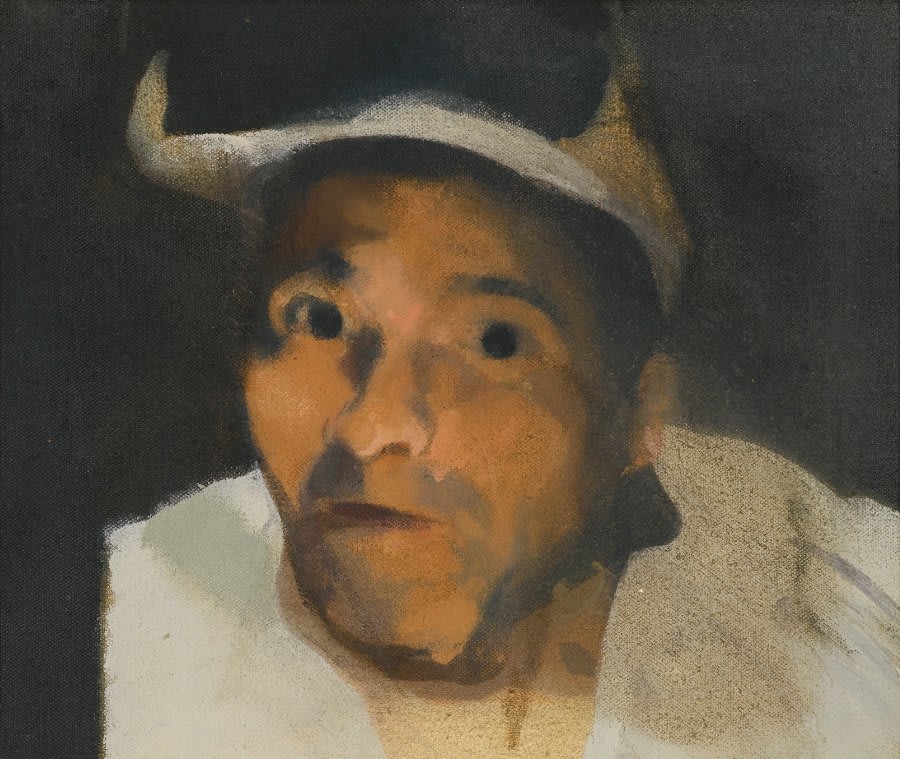Michael Andrews 1923-1995
25 x 30 cm
In the mid-1960s Michael Andrews was consumed by the idea of Zen enlightenment and began contemplating a series of paintings which were to imagine a metaphorical journey of the soul. Having happened upon a phrase written by psychiatrist R D Laing - ‘the skin-encapsulated ego’ - and having seen an image of a balloon floating above the English country side, he felt he could construct an imagery which related to the loss of the ego - and the freedom which comes from this loss, through the motif of the balloon’s journey.
It was the sense of floating or flying above the ground which he found appealing, and felt was a usable collective metaphor, one which pervades across cultural and physical boundaries:
‘We dream of flying. Usually there is the sensation of leaving the ground and suddenly acquiring the ability to float over obstacles and keep going, by sheer will and power, across land and sea. It is a common dream - escapism, obviously - reflecting universal aspirations. It is the romantic impulse of Shelley’s Ode to the West Wind: “If I were a swift cloud to fly with thee.”’ (The Artist, quoted in Michael Andrews: Lights (exh. cat.), The British Council, 20th June – 1st October 2000, p.17)
The resulting series, Lights, was made up of seven paintings produced over a period of 5 years, from 1970 to 1975. Through pictorial metaphors these paintings explored human experience and the concept of personal voyage. In continuation of this exploration, Andrews went onto paint another series of works, his ‘Cabin sketches’ which resulted in the painting Cabin (fig. 1, 1975, Private Collection, Paris). Whereas in Lights, the balloon acted as a metaphor for the release of one’s soul, in Cabin the aeroplane acts as a container for the soul. As William Feaver has noted the aeroplane represents, 'ships of fools: containers of illusions about getting somewhere in life. In this they relate, perceptibly, to disaster movies.' (p.54, Tate).
The present work is one of several preparatory studies that Andrews made for Cabin. Initially, inspired by his daughter, who had made a drawing of passengers waving out of plane windows, the artist intended to include these passengers within the final painting. Here we view them as if we are floating outside of the aeroplane, facing into each of their personal pilgrimages.
The present work has a particularly profound impact as this passenger seems to be staring straight out of the darkness towards us. As with all of Andrews painting it appears to be imbued with an ulterior significance- it communicates directly with the viewer and here Andrews uses the portrait to articulate the character of the human soul and as a means by which to represent a more universal human experience. The formal qualities- the strongly rendered chiaroscuro- enhances this notion by adding a certain drama and spirituality to the picture and evoke historical examples in which the portrait is used to the same end such as Rembrandt’s self portraits. These dramatic works are appreciated not only for their formal quality but for the power with which they suggest the character of the sitter and by default, the essence of their soul. As artist Vincent Van Gogh once said, "In Rembrandt's portraits, it is more than nature, it is a kind of revelation . . . . [He] penetrates so deeply into the mysteries that he says things for which there are no words in any language."
Provenance
Anthony d'Offay Gallery, London
Colin St John Wilson
Exhibitions
London, Hayward Gallery, Michael Andrews, 31 October 1980 - 11 January 1981, Arts Council of Great Britain, cat no. 95, illus, touring to:
Edinburgh, Fruit Market Gallery, 24 January -21 February
Manchester, Whitworth Art Gallery, 6 March - 20 April
London, Tate Britain, Michael Andrews, 19 July - 7 October 2001, cat no.44, illus colour
